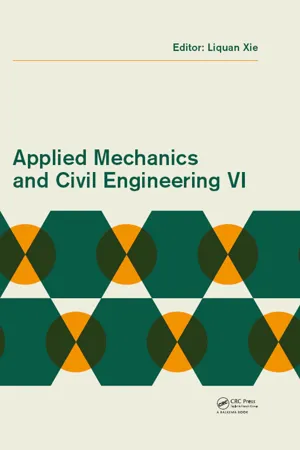
- 234 pages
- English
- ePUB (mobile friendly)
- Available on iOS & Android
Applied Mechanics and Civil Engineering VI
About this book
Applied Mechanics and Civil Engineering VI includes the contributions to the 6th International Conference on Applied Mechanics and Civil Engineering (AMCE 2016, Hong kong, China, 30-31 December 2016), and showcases the challenging developments in the areas of applied mechanics, civil engineering and associated engineering practice. The book covers a wide variety of topics:
- Applied mechanics and its applications in civil engineering;
- Bridge engineering;
- Underground engineering;
- Structural safety and reliability;
- Reinforced concrete (RC) structures;
- Rock mechanics and rock engineering;
- Geotechnical in-situ testing & monitoring;
- New construction materials and applications;
- Computational mechanics;
- Natural hazards and risk, and
- Water and hydraulic engineering.
Applied Mechanics and Civil Engineering VI will appeal to professionals and academics involved in the above mentioned areas, and it is expected that the book will stimulate new ideas, methods and applications in ongoing civil engineering advances.
Frequently asked questions
- Essential is ideal for learners and professionals who enjoy exploring a wide range of subjects. Access the Essential Library with 800,000+ trusted titles and best-sellers across business, personal growth, and the humanities. Includes unlimited reading time and Standard Read Aloud voice.
- Complete: Perfect for advanced learners and researchers needing full, unrestricted access. Unlock 1.4M+ books across hundreds of subjects, including academic and specialized titles. The Complete Plan also includes advanced features like Premium Read Aloud and Research Assistant.
Please note we cannot support devices running on iOS 13 and Android 7 or earlier. Learn more about using the app.
Information
(1) |
Table of contents
- Cover
- Half Title
- Title Page
- Copyright Page
- Table of Contents
- Preface
- Behavior of large deformation and supporting measures in soft rock tunnel
- Integrating in situ tests on the excavation damaged zone of underground caverns
- Screening of Lactobacillus rhamnosus capable of yielding high levels of Conjugated Linoleic Acid by UV mutagenesis
- A method for intelligent safety monitoring and hazard warning of highway dangerous rock
- Studies on the mechanism of ecological restoration of eutrophic water in a tropical shallow urban lake
- Development of a modal identification method using the random decrement technique combined with HHT
- Study on the creep characteristics and constitutive model of schist in natural and saturated states
- Effect of Nano-CaCO3 on performance of cement and concrete
- Study of rock loosening deformation and security characteristics of columnar jointed basalt based on monitoring information fusion
- Low-energy environmental improvement for glass curtain wall buildings
- Study on the mechanical properties of a damaged steel beam
- Structural behavior analysis of the steel frame of a damaged beam end
- Application of stable isotopes in the study of lake and reservoir leakage
- Root cause analysis of the collapse accident at the Tsinghua university high school construction site using “24 model”
- Research on the development law of pore pressure during shearing of the saturated dense silty soil by the rake tooth
- Study on the punching shear strength and deformation capacity of RC slabs based on a database
- Experimental study on impact localization based on wavelet analysis
- Analysis of shield tool wear problems in a variable compound stratum
- Anchor cable encircled modes of unbonded annular anchors for pre-stressed tunnel lining
- Simulation of oil transport after oil spill in the Bohai Sea
- The construction technology of Earth Pressure Balance shield in sand stratum section
- Effect of chemical–mechanical activation on the cementitious activity of iron ore tailings
- The design value of vertical earth pressure on hydraulic tunnels
- Numerical simulation of sediment erosion and transport in the diversion tunnels of a hydropower station
- Lattice Boltzmann modeling of two-phase flows in complex porous media considering surface hydrophobicity
- Optimization of primary support parameters for the main structure of the tunnel of Beijing
- Processes of storm-induced fluid mud formation in open muddy channels
- Analysis of runoff variation trend of the Dongting Lake in China
- Numerical simulation of the lock release gravity current in a linearly stratified environment
- Simplified method to calculate buoyancy in multi-layered strata
- Effect of dissolved oxygen on nitrate removal from drinking groundwater using rice wine
- Low-frequency variability of sea surface height in the tropical Pacific Ocean
- Study on the effect of water content on the stability of gypsum pillars
- Study of the material parameters of self-anchored suspension bridges
- Author index